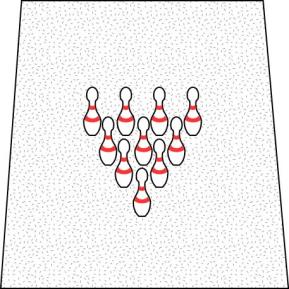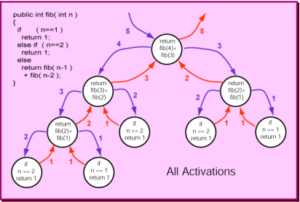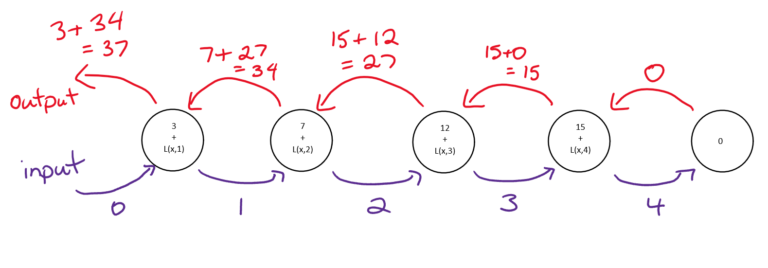ICS4U – Recursion in Python
ICS4U Learning Goals
In this ICS4U Grade 12 Computer Science lesson you will be learning how to
- Define problems recursively
- Implement some straightforward recursive algorithms
What is Recursion?
You are used to programming and solving problems using control structures such as if-else statements (selection structures) and iterative loops (repetition structures)
Another control mechanism that can be used in problem solving and programming is recursion
The basic idea behind recursion is this:
- If the problem is considered easy solvable, solve it immediately
- If the problem can’t be solved immediately, divide it into easier problems, then solve the
easier problems
Generally when a problem can be defined in terms of itself then it can be solved recursively
Triangle Numbers
The total number of pins in a triangular arrangement is called a triangle number.

You can expand that pattern by keep adding rows with more pins
- Row 1 -> 1 Pin
- Row 2 -> 3 Pins
- Row 3 -> 6 Pins
- Row 4 -> 10 Pins
- Row 5 -> 15 Pins
- Row 6 -> 21 Pins
- Row 7 -> 28 Pins
There is a pattern here:
- Total # pins in row 1 = 1
- Total # pins in row 2 = 2 + Total # of pins in row 1
- Total # pins in row 3 = 3 + Total # of pins in row 2
- Total # of pins in row 4 = 4 + Total # of pins in row 3
- Total # of pins in row 5 = 5 + Total # of pins in row 4
Mathematically you can write out the # of pins in the Nth row as
Triangle (N) = N + Triangle (N – 1)
Triangle(3)
- = 3 + Triangle(2)
- = 3 + (2+Triangle(1))
- = 3 + (2 + (1))
- = 6
Triangle (7)
- = 7 + Triangle(6)
- = 7 + (6 + Triangle(5))
- = 7 + (6 + (5 + Triangle(4)))
- = 7 + (6 + (5 + (4 + Triangle(3))))
- = 7 + (6 + (5 + (4 + (3 + Triangle(2)))))
- = 7 + (6 + (5 + (4 + (3 + (2 + Triangle(1))))))
- = 7 + (6 + (5 + (4 + (3 + (2 + 1)))))
- = 28
Because you have defined the Nth Triangle number in terms of itself, this is a perfect problem to solve recursively.
Notice that in both examples above the sequence of additions ended with Triangle(1) = 1. This is called the base case for the problem
- A base case is a problem that can be easily solved immediately
- It typically tells you when the recursion should stop
def triangle(N):
#Base Case
if N == 1:
return 1
#Recursive Call
else:
return N + triangle(N-1)
Notice that the Tell Tale Sign of a Recursive Function call in programming is that you define a function that calls itself
ICS4U Interactive Learning Activity - Grade 12 Computer Science
Write a main program for the Triangle Function defined above and test to see if you are getting the correct results
- Try multiple different values of N
- Try printing the value of N inside the function, and you will see the sequence of calls printed out
Go to the following website and watch how the function works its way through until the base case is hit and the recursion stops.
- When you see a pink box, you can click on it to interact and watch the function calls
- You might notice that the website talks about Java, but the explanation is good and its pretty much the same anyways.
def triangle(N):
if N == 1:
return 1
else:
return N + triangle(N-1)
def main():
num = int(input("Calculate Triangle Number for N = "))
tNumber = triangle(num)
print("Triangle(",num,") = ", tNumber)
main()
Fibonacci Sequence
You have probably studied and are familiar with the Fibonacci Sequence of numbers
1,1,2,3,5,8,13,,21,34,55,….
Each value in the sequence is found by adding the previous two values in the sequence.
Mathematically we can define this as
Fib (N) = Fib(N-1) + Fib(N-2) for N >= 3
The base cases for this recursion are Fib(1) = 1 and Fib(2) = 1
Translating that into a python function would look as follows
def fib(N):
if N == 1 or N == 2:
return 1
else:
return fib(N-1) + fib(N-2)
ICS4U Interactive Learning Activity - Grade 12 Computer Science
Look at the following recursive activation diagram for trying to find the 5th Fibonacci number
- Purple arrows are the values being sent to the function
- Red arrows are the values returned from the function

- You can trace through the activations of the recursive calls here
- Try to draw the activation for the 7th fibonacci Number
Iteration vs Recursion
You might be wondering, why recursion is necessary at all, when the two programs above could have easily been written with a loop.
Iterative Triangle Number
If you look at the pattern that occurs for the Nth triangle number, you will see that its value is just the sum of the numbers from 1 to 10
- Triangle(3) = 6 = 1 + 2 + 3
- Triangle(7) = 28 = 1 + 2 + 3 + 4 + 5 + 6 + 7
That is easily accomplished using a simple loop
def triangle(N):
sum = 0
for i in range(1,N):
sum = sum + i
return sum
Iterative Fibonacci Sequence
This one might be a little more complicated to understand from a looping perspective, but just need to keep track of the previous two values in some variables.
def fib(N):
f1 = 1
f2 = 1
for i in range(1,N-1):
nextValue = f1 + f2
f1 = f2
f2 = nextValue
return f2
Well, the answer to the above question of recursion vs iteration, isn’t exactly straight forward.
Generally Speaking
- Code size is smaller and sometimes logically easier to understand using recursion
- Iterative solutions are usually faster (It takes more time to call functions then to execute a loop)
- Recursion can take up more memory and is subject to Stack Overflow Errors
- Some problems are just naturally recursive in nature
- Towers of Hanoi
- Maze Solving
- Sorting Methods
ICS4U Interactive Learning Activity - Grade 12 Computer Science
Comparing Execution Times - Triangle Numbers
Run the Following Code to compare the execution times for the iterative vs the recursive Triangle Number Algorithms
- Try a small number < 10
- Try a number between 10 and 100
- Try a number over 1000000
import timeit
def triangleRecursive(N):
if N == 1:
return 1
else:
return N + triangleRecursive(N-1)
def triangleIterative(N):
sum = 0
for i in range(1,N+1):
sum = sum + i
return sum
def main():
num = int(input("Calculate Triangle Number for N = "))
print("\nRecursive:")
start = timeit.default_timer()
tNumber = triangleRecursive(num)
end = timeit.default_timer()
elapsedNS = round((end - start)*10**9)
print("Triangle(",num,") = ", tNumber)
print("Solution took",elapsedNS,"nanoseconds\n")
print("Iterative:")
start = timeit.default_timer()
tNumber = triangleIterative(num)
end = timeit.default_timer()
elapsedNS = round((end - start) * 10 ** 9)
print("Triangle(", num, ") = ", tNumber)
print("Solution took",elapsedNS,"nanoseconds")
main()
Comparing Execution Times - Fibonacci Numbers
Run the Following Code to compare the execution times for the iterative vs the recursive Fibonacci Number Algorithms
- Try a small number < 10
- Try 35
- Try 40 -> Be patient, very very very patient…..
- Try a number over 1000000
import timeit
def fibRecursive(N):
if N == 1 or N == 2:
return 1
else:
return fibRecursive(N-1) + fibRecursive(N-2)
def fibIterative(N):
f1 = 1
f2 = 1
for i in range(1,N-1):
nextValue = f1 + f2
f1 = f2
f2 = nextValue
return f2
def main():
num = int(input("Calculate the Fibonacci Number for N = "))
print("\nRecursive:")
start = timeit.default_timer()
fNumber = fibRecursive(num)
end = timeit.default_timer()
elapsedNS = round((end - start)*10**9)
print("Fibonacci(",num,") = ", fNumber)
print("Solution took",elapsedNS,"nanoseconds\n")
print("Iterative:")
start = timeit.default_timer()
fNumber = fibIterative(num)
end = timeit.default_timer()
elapsedNS = round((end - start) * 10 ** 9)
print("Fibonacci(", num, ") = ", fNumber)
print("Solution took",elapsedNS,"nanoseconds")
main()
Python Stack and Overflow Errors
You will learn in the next unit about a data structure called a Stack, but when python makes function calls, that structure is used to store the set of new local variables and parameters each time the function is called. There is only so much space that is available on that stack, and as we have seen, the amount of function calls that a recursive solution can make can become very high.
In the previous learning activity you probably noticed that you were getting a Recursion Depth Exceeded error. This is a stack overflow error where there are too many functions calls and the stack wouldn’t have enough space to handle that many.
Iterative vs Recursive GCD
The greatest common divisor (GCD) algorithm is another common algorithm that can be written both recursively and iteratively. It finds the largest factor that exists between 2 numbers (a,b)
You can see the simplicity of the recursive code vs the iterative version
def gcd(a,b):
if a == 0:
return b
else:
return gcd(b % a , a)
def gcd(a, b):
# Largest divisor 1 -> if no other ones found
g = 1
# start search for divisors at the smallest number
if a > b:
start = b
else:
start = a
# Count backwards to find the largest divisor
for i in range(start, 1, -1):
# Found largest divisor so stop
if a % i == 0 and b % i == 0:
g = i
break
return g
Towers of Hanoi
The Towers of Hanoi Problem is a traditional mathematical problem that can be solved using recursion. Watch the video and see if you can understand the algorithm. The code it gives is not in Python, but see if you can simulate this puzzle yourself in Python if you have time, but I’m more concerned with you just getting familiar on how this could be solved recursively
Counting
Here is an example of a recursive function that counts up by 3 for N number of times.
def count3(N):
if N == 0:
return 0
else:
return 3 + count3(N-1)
def main():
#Counts up by 3 5 times, so prints 15
print(count3(5))
#Counts up by 3 20 times, so prints 60
print(count3(20))
main()
The recursion is acting like a loop in this case, executing N number of times and adding 3 each time the recursive function is called
ICS4U Coding Questions
Try to code the following questions using an IDE of your choice. You will save those files on your computer for future reference.
Each question has:
- A video of your teacher live coding and explaining the solution
- The final code used in the video.
Try your best to solve the problems yourself without looking at the solutions.
Make sure you test your programs with multiple different inputs to ensure it is functioning properly.
Treat these questions like Math homework (Do as many as you feel you need to do to feel comfortable with the material)
ICS4U Practice Question
Name Your File: “ICS4Ufactorial.py”
Write a recursive solution to calculating a factorial. The factorial of a number N is the product of all the numbers from 1 to N. Mathematically a factorial is written as N!
- 5! = 5 x 4 x 3 x 2 x 1
- 6 ! = 6 x 5 x 4 x 3 x 2 x 1
- 7! = 7 x 6 x 5 x 4 x 3 x 2 x 1
This definition is recursive because the Nth factorial is N multiplied by the N-1 factorial
- Factorial(N) = N * Factorial(N-1)
- By definition in math the factorial of zero is 1 (That is the base case)
def factorial(N):
if N == 0:
return 1
else:
return N * factorial(N-1)
ICS4U Practice Question
Name Your File: “ICS4Usquared.py”
In this question you are going to write a recursive function for implementing the Square of a Number 𝑁2.
An interesting way to compute the square of a number is to use the fact that
- (N-1)2 = N2 – 2N + 1
which would mean that
- N2 = (N-1)2 + 2N – 1
def squared(N):
if N == 1:
return 1
else:
return squared(N-1) + 2 * N - 1
ICS4U Practice Question
Name Your File: “ICS4UpyramidalNumbers.py”
Let’s take a look at a tetrahedron made up of tennis balls.
- Start with a triangular arrangement of tennis balls for the bottom layer (Each side of the triangle has the same number of tennis balls)
- Next Stack up tennis balls a layer at a time until there is only 1 ball at the top of the pyramid


The Nth pyramidal number is the total number of balls in a pyramid that has a base side length of N tennis balls
You can solve this problem by adding up the number of balls in each layer (which just happen to be the Triangle Numbers from the lesson)

Notice that the Nth pyramidal number is just the Nth Triangle Number plus the pervious Pyramidal Number
Write a recursive function to find Pyramidal Number and draw the activation diagrams showing the recursive calls for N = 3
def triangle(N):
if N == 1:
return 1
else:
return N + triangle(N-1)
def pyramidal(N):
if N == 1:
return 1
else:
return pyramidal(N-1) + triangle(N)
def main():
num = int(input("Enter N: "))
print(pyramidal(num))
main()

ICS4U Practice Question
Name Your File: “ICS4UsumOfList.py”
It is possible to write an algorithm that finds the sum of the values inside a list using recursion as well
- sumList(theList,index) = theList[index] + sumList(theList, index + 1)
The base case is when the index is equal the length of theList and the recursive function should return 0
Write the function to implement this sum recursively
- test it out with different lists
Draw the activation diagram showing the recursive calls for the following list
- [3,7,12,15]
def sumList(theList,index):
if index == len(theList):
return 0
else:
return theList[index] + sumList(theList, index + 1)
def main():
x = [1,2,3,4,5]
print(sumList(x,0))
x = [4,3,7,12,17,20,22]
print(sumList(x, 0))
main()

Return to ICS4U Main Page

